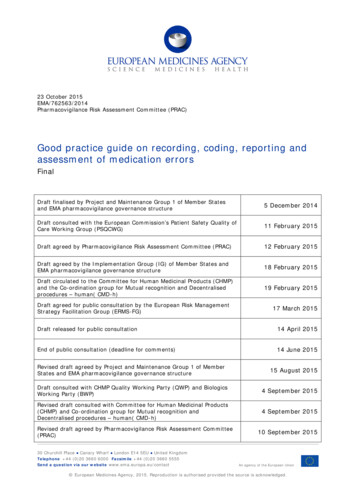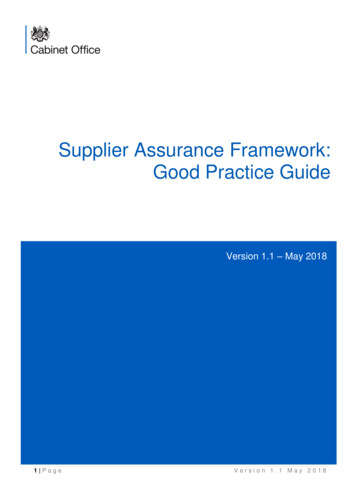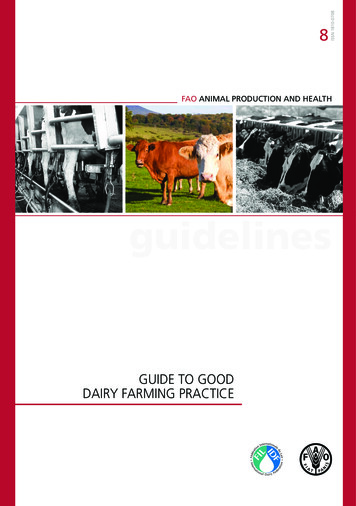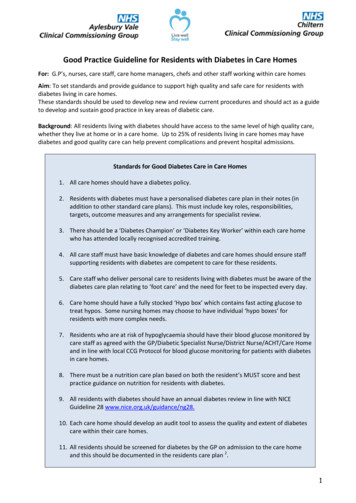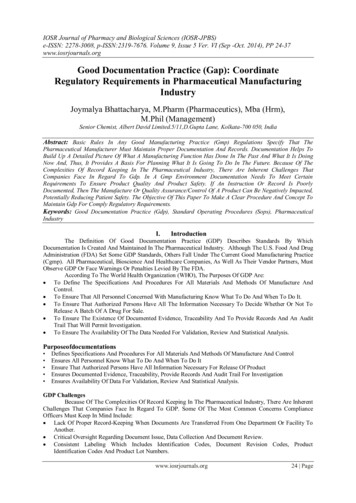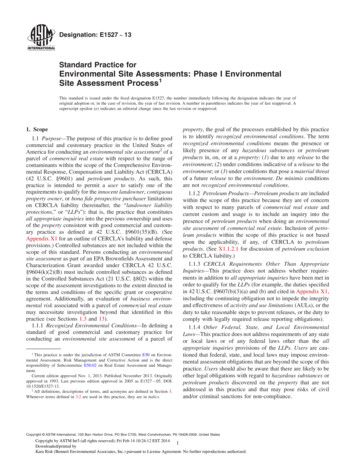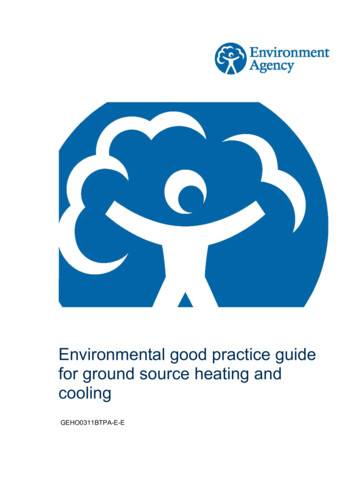
Transcription
Environmental good practice guidefor ground source heating andcoolingGEHO0311BTPA-E-ETitle here in 8pt Arial (change text colour to black)i
We are The Environment Agency. It's our job to look after yourenvironment and make it a better place – for you, and for futuregenerations.Your environment is the air you breathe, the water you drink and theground you walk on. Working with business, Government andsociety as a whole, we are making your environment cleaner andhealthier.The Environment Agency. Out there, making your environment abetter place.To contact us:Call: 08708 506 506 (Mon-Fri 8-6)Email: enquiries@environment-agency.gov.ukWebsite: www.environment-agency.gov.ukPublished by:Environment AgencyHorizon House, Deanery RoadBristol BS1 5AHTel: 0117 934 4000Email: agency.gov.uk Environment AgencyAll rights reserved. This document may bereproduced with prior permission ofthe Environment Agency.iiFurther copies of this report are availablefrom our publications v.uk or our National CustomerContact Centre: T: 08708 506506E: enquiries@environment-agency.gov.uk.Environment Agency: Environmental good practice guide for ground source heating and coolingVsn 3
Contents1Introduction11.1Using this guide11.2Types of scheme11.3Environmental risks of GSHC schemes and your role42General requirements for GSHC schemes52.1Assessment of environmental impacts52.2Environmental risks related to scheme location52.3General good practice for excavations and drilling82.4Good practice for borehole completion112.5Decommissioning123Good practice guidance – closed loop schemes133.1Our approach to closed loop schemes133.2Liability for pollution from closed loop schemes133.3Horizontal closed loop schemes143.4Good practice for pollution prevention143.5Loop construction and pressure testing of indirect closed loop schemes163.6Thermal transfer fluid173.7Direct circulation (DX) closed loop installations183.8Post installation care and maintenance184Open loop schemes194.1Introduction194.2General well construction and operation principles204.3Groundwater investigation consent and abstraction licence214.4Discharge of water from your scheme234.5Open loop schemes and contaminated water254.6Recharge well hydraulic impacts264.7Pumping of particulate matter265Further y31Appendix A1 – best practice checklistEnvironment Agency: Environmental good practice guide for ground source heating and cooling33iii
Table 1.1Table 1.2Table 2.1Table 2.2Table 4.1Figure 1.1Figure 1.2Figure 2.1Figure 2.2Figure 4.1Summary of current permit requirements for different types of water source heating and coolingschemes - closed loopSummary of current permit requirements for different types of water source heating and coolingschemes - open loopSite checklistGeological checklistDetailed approach to permitting of discharges335924Schematic of open loop GSHC scheme where groundwater is used for heating2Schematic of horizontal closed loop and vertical closed loop GSHC scheme2The risk associated with drilling in contaminated ground or groundwater shown in a closed loop systeminstalled in an aquifer (in this case a sandstone), but the same concerns would apply to an open loopsystem8The risks associated with drilling in a multiple aquifer situation. A closed loop system installed throughseveral aquitards (such as clay) and aquifer (such as limestone, sandstone or sand/gravel) horizons 11Current regulatory pathway for open loop GSHC systems (modified after Fry, 2009), showing theseparate permitting systems required for different stagesiv Environment Agency: Environmental good practice guide for ground source heating and coolingVsn 3
1 IntroductionGround source heating and cooling (GSHC) systems use energy stored in the groundto heat or cool buildings. They can also provide hot water. Electricity, and sometimesother sources such as gas, is used to power the heat pumps and they can typicallyprovide three to four times the amount of energy used to drive the system, dependingon their design.1.1 Using this guideThis environmental good practice guide (EGPG) is for designers, developers, installers,drillers and owners of GSHC schemes. It sets out what needs to be done to complywith environmental legislation and manage environmental risks.Following the guide will help you to meet your legal requirements and reduce the riskthat your scheme causes environmental harm. It is in your interest to avoidenvironmental harm as it can lead to legal action, including by third parties claimingdamages. It could also damage your reputation and that of the industry.This EGPG is not intended to provide guidance on health and safety or designingthermally efficient or cost-effective systems as such guidance can be sought elsewhere(see section 5 for links to sources of further information).We expect operators of GSHC schemes to install, manage and decommission allGSHC schemes carefully following this EGPG and to adhere to the conditions we set.This section sets out the types of GSHC scheme and highlights possible environmentalimpacts and legislation for all types of GSHC scheme. Section 2 details good practiceand legislative requirements for both open and closed loop systems in terms oflocation, excavation and drilling. For those planning to install a closed loop GSHCscheme, section 3 details good practice for pollution prevention and installation of yourscheme. For those planning to install an open loop scheme, section 4 details the goodpractice and the statutory requirements for the environment for this type of scheme.Appendix A1 contains a summary of what to consider ensuring protection of theenvironment.1.2 Types of schemeThis guide deals with the two main types of GSHC system: closed loop and open loop.In open loop systems, water is abstracted from the ground and pumped through a heatexchanger and then it is normally pumped back into the ground (see figure 1.1). Wherethe same volume of water is returned to the same aquifer the scheme is classed asnon-consumptive and does not affect the water resource. Some schemes which usethe water for other purposes or discharge into a sewer or surface water are classed asconsumptive.1
HeatpumpWater tablePumpGROUNDWATERFigure 1.1 Schematic of open loop GSHC scheme where groundwater is used forheating.Closed loop systems consist of a closed pipe system buried in the ground and filledwith thermal transfer fluid (which comprises anti-freeze, biocide, corrosion and scaleinhibitors). When the liquid travels around the pipe loops, it absorbs heat from, or givesheat out to the ground (see figure 1.2).HeatpumpHeatpumpFigure 1.2 Schematic of horizontal closed loop and vertical closed loop GSHCschemeIn addition to ground source schemes, there are also water source heating and coolingschemes. These may be closed loop in rivers, lakes and ponds or may be open loop2 Environment Agency: Environmental good practice guide for ground source heating and coolingVsn 3
and abstract water directly from (and discharge water to), rivers, lakes, ponds or eventhe sea. Some schemes may be a hybrid of these types where water may beabstracted from the groundwater and returned, for example, to rivers. This guidecovers both the groundwater abstraction and discharge. It does not cover surface waterabstraction and discharge. For more information and detail on regulation of surfacewater abstraction and discharge, see table 1.2 and the web links in the table.GSHC schemes should be distinguished from deeper geothermal schemes (severalkilometres deep) which use the earth’s internal heat, which increases with depth. Incontrast GSHC schemes use the stable temperatures of the ground and groundwater,at much shallower depths. This document solely considers GSHC schemes and notdeep geothermal schemes.A summary of environmental permissions for different types of schemes are detailed inthe table 1.1 and 1.2. More details can be found in section 4.Tables 1.1 and 1.2 Summary of current permit requirement for different types of water sourceheating and cooling schemesClosedloopInstallation inGroundNo permitneededSurface waterFlood defence consent may be needed in rivers. Contactus for more information1Abstraction fromOpenloopDischarge toGroundwaterSurface waterGroundwaterSurface waterSee section 4 fordetails. Consentto investigategroundwater, andan abstractionlicence requiredfor abstractionsover 20 cubicmetres per dayAbstractionlicence requiredfor abstractionsover 20 cubicmetres per day,apply as anyotherabstractionlicence, see ourwebsiteSee section 4.Bespokeenvironmentalpermit requiredSee section 4 fordetails. Deregulated,standard or bespokeenvironmental permitdepending on risk.Further details can befound on our website.In addition, any worksin or near a river mayrequire a flooddefence consent11A flood defence consent is likely to be needed if you plan to put any pipework near or in a river, or youare changing a river bank (for example putting in an outfall). These fall into the following categories: Works within Main River and flood defence byelaw distance. These distances will vary around thecountry and so please contact us for more information. Main Rivers are watercourses designated as suchon Main River maps (held by the us) and are generally the larger arterial watercourses. Works to an ordinary watercourse such as culverting (a pipe through which a watercourse flows) orobstructing the flow (e.g. weirs or dams). These are all watercourses not designated as a Main River.3
1.3 Environmental risks of GSHC schemes and your roleThe main environmental risks associated with GSHC schemes are listed below. All GSHC systems can result in undesirable temperature changes in theground and the water environment with impacts on water quality or aquaticecology. Both open loop systems and closed systems installed at depth can result inthe interconnection of different aquifers units during drilling - affecting waterquality or flow. Closed loop systems may contain thermal transfer fluids which are toxic andcan pollute groundwater if they leak.Open loop systems present the following additional environmental risks: Localised increase in groundwater levels which could affect adjacentstructures. The potential impact of groundwater abstraction on the environment or otherusers of groundwater or surface water.Developers of open loop systems should contact the Environment Agency at an earlystage to discuss the intended location, proposed design, and operation of their system.Developers of closed loop schemes where there may be environmental risks such aswithin a groundwater source protection zone should also contact us at an early stage.Significant consideration must be given to the design of both open and closed loopschemes in order to ensure their longevity and efficient performance. Such designconsiderations do not fall within our remit. Organisations such as the Ground SourceHeat Pump Association and International Ground Source Heat Pump Association haveuseful publications to help with these considerations.4 Environment Agency: Environmental good practice guide for ground source heating and coolingVsn 3
2 General requirements forGSHC schemesThe guidance provided in this section is relevant to all types of schemes. In addition,there are regulatory requirements for open loop schemes to assess the environmentalimpacts of both the abstraction and discharge as part of the application process,detailed in section 4. There is no formal need to obtain consent from us for a closedloop scheme. Other permissions may be needed, for example planning permissionwhich may have associated conditions. The boxed text in bold highlights your statutoryenvironmental obligations. A checklist of the items you need to consider whenplanning a new scheme, both closed and open loop, is included as Appendix A1. Thiscontains references to the relevant sections of this guide to help you.2.1 Assessment of environmental impactsA competent person (for example a trained geological or hydrogeological professional)should carry out an assessment of the environmental impact of your scheme anddocument the results. The assessment should take into account the risks listed insection 1.3, as well as sections 2.2 – 2.5 below.The majority of these (except Note 6) relate specifically to vertical borehole schemesand not necessarily horizontal closed loop schemes which generally present a lowerrisk to the environment. This tick box should be used however if horizontal schemesare installed below the water table.2.2 Environmental risks related to scheme locationAs part of your environmental impact assessment you should use the checklist belowto find out if your proposed GSHC scheme is in a sensitive location. We recommendthat you avoid such locations if possible but if you cannot do this, the notes belowexplain what you should do.Table 2.1 Site checklistTick boxYes NoCheck whether the proposed site is in these locationsWithin a defined groundwater source protection zone 1 orwithin 50m from a well, spring or borehole used for potablesupply?On land affected by contamination?Close2 to a designated wetland site?Within 10m of a watercourse?Close1 to other GSHC schemes?Adjacent to a septic tank or cesspitNotenumber1234562This will depend on the size of the scheme: for open loop schemes it will be based on pumping rate andwhether the heat demand is for both heating and cooling and will need to be considered by the applicant.For closed loop, it will depend on the size of the thermal input into the ground but a simple guide for closedloop schemes could be: 20m for single domestic scheme (assuming this is at 45kW as defined by MCS),50m for a few houses/single community building to at least 250 m for factory/ large office space.5
Note 1: Find out if your proposed site is in a groundwater source protection zone 1(SPZ1), by checking t
to heat or cool buildings. They can also provide hot water. Electricity, and sometimes other sources such as gas, is used to power the heat pumps and they can typically provide three to four times the amount of energy used to drive the system, depending on their design. 1.1 Using this guide
